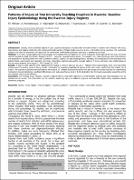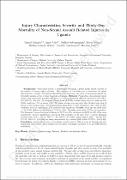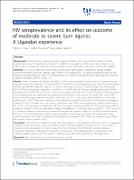| dc.contributor.author | Petroze, RT | |
| dc.contributor.author | Mumararungu, A | |
| dc.contributor.author | Ndayiragije, V | |
| dc.contributor.author | Ntakiyiruta, G | |
| dc.contributor.author | Kyamanywa, Patrick | |
| dc.contributor.author | Reid, J | |
| dc.contributor.author | Calland, JF | |
| dc.contributor.author | Byiringiro, JC | |
| dc.date.accessioned | 2022-04-07T14:54:29Z | |
| dc.date.available | 2022-04-07T14:54:29Z | |
| dc.date.issued | 2014 | |
| dc.identifier.citation | Petroze, R.T., Mumararungu, A., Ndayiragije, V., Ntakiyiruta, G., Kyamanywa, P., Reid, J., Calland, J.F. and Byiringiro, J.C. (2014). Patterns of injury at two university teaching hospitals in Rwanda: baseline injury epidemiology using the Rwanda Injury Registry. Rwanda Med J, 71(1), pp.5-8. | en_US |
| dc.identifier.issn | 2079-097X | |
| dc.identifier.issn | 2410-8626 (online) | |
| dc.identifier.uri | http://hdl.handle.net/20.500.12280/2931 | |
| dc.description.abstract | Introduction: Globally, more worldwide deaths in 2010 could be attributed to injuries than the total number of deaths from infection with AIDS, tuberculosis, and malaria combined, with a disproportionate number of these deaths occurring in low- and middle-income countries. Yet, worldwide research and plans for prevention of injuries are far below other world health problems, especially in developing countries.
Methods: A 31-item, 2-page registry form was adapted from regional trauma registries for use in Rwanda to collect data at the two main university referral hospitals in Kigali and Butare. Beginning in 2011, registrars recorded demographics, pre-hospital care, initial physiology, early interventions,
and disposition of injured patients who met our selection criteria. Inpatient 30-day discharge status, mortality, and complications were abstracted from patient charts, ward reports and operating room logs. Descriptive analysis was used to evaluate patterns of injury and basic injury epidemiology at
the two study hospitals from August 1, 2011-January 31, 2013.
Results: A total of 3599 patients were registered from August 1, 2011 to January 31, 2013. Patients were predominantly male, and road traffic crashes were the leading cause of injury overall, contributing to a greater proportion of injuries in the more urban capital than the smaller city of Butare. The majority of patients were admitted to the hospital. All variables evaluated except for the percentage of injuries acquired via a penetrating mechanism showed statistically significant differences at an alpha significance level of 0.05, illustrating that the trauma population presenting at the two hospitals may be quite different.
Conclusion: The Rwanda Injury Registry indicates a high burden of road traffic injuries in a predominantly working age male population over an eighteen-month period. This information can be useful in expanding injury surveillance programs and hopefully implementing population-based prevention programs. | en_US |
| dc.language.iso | en | en_US |
| dc.publisher | RBC / Rwanda Health Communication Centre | en_US |
| dc.relation.ispartofseries | Rwanda Medical Journal;71(1) | |
| dc.subject | Injuries | en_US |
| dc.subject | Injury registry | en_US |
| dc.subject | Trauma registry | en_US |
| dc.subject | Outcomes | en_US |
| dc.subject | Road traffic crashes | en_US |
| dc.subject | Road traffic accident | en_US |
| dc.title | Patterns of Injury at Two University Teaching Hospitals in Rwanda: Baseline Injury Epidemiology Using the Rwanda Injury Registry | en_US |
| dc.type | Article | en_US |




